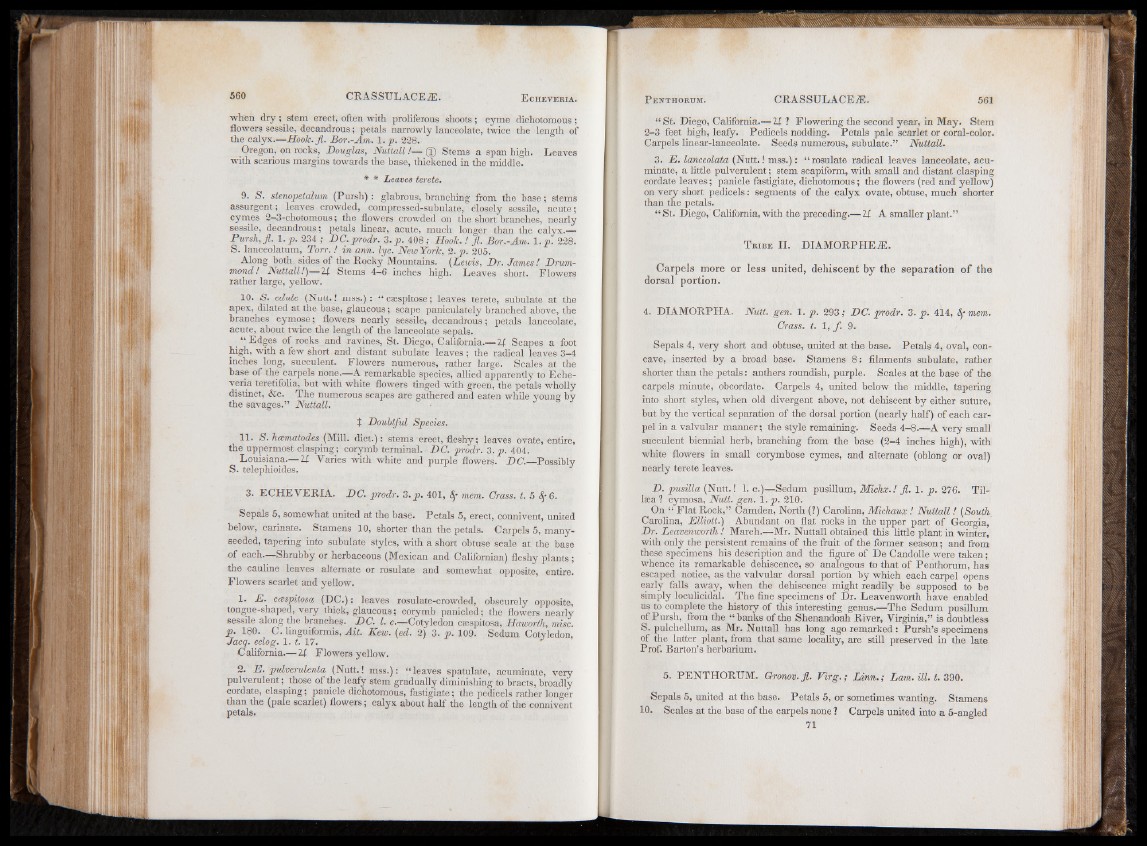
when dry ; j stem erect, often with proliferous shoots ; cyme dichotomous ;
flowers sessile, decandrous; petals narrowly lanceolate, twice the length of
the calyx.—Hook.fl. Bor.-Am. 1. p. 228.
Oregon, on rocks, Douglas, Nuttall!—, (T) Stems a span high. Leaves
with searious margins towards the base, thickened in the middle.
* * jLeaves terete.
9. S. stenopetalum (Pursh): glabrous, branching from the base; stems
assurgent; leaves crowded, compressed-subulate, closely sessile, acute;
cymes 2—3-chotomous; the flowers crowded on the short branches, nearly
sessile, decandrous; petals linear, acute, much longer than the calyx.—
Pursh, Jl. l .p . 234 ; DC. prodr. 3. p. 408 ; HooTc. ! Jl. Bor.-Am. l .p . 228.
S. lanceolatum, Torr. ! in ann. lyc. New York, 2. p. 205.
Along both sides of the Rocky Mountains. (Lewis, Dr. James ! Drummond.
1 Nuttall!)— 2! Stems 4—6 inches high. Leaves short. Flowers
rather large, yellow.
10. S. edule (Nutt.! mss.): “ caespitose; leaves terete, subulate at the
apex, dilated at the base, glaucous; scape paniculately branched above, the
branches cymose; flowers nearly sessile, decandrous; petals lanceolate,
acute, about twice the length of the lanceolate sepals.
“ Edges of rocks and ravines, St. Diego, California.— If Scapes a foot
high, with a few short and distant subulate leaves; the radical leaves 3—4
inches long, succulent. Flowers numerous, rather large. Scales at the
base of the carpels none.—A remarkable species, allied apparently to Eche-
veria teretifolia, but with white flowers tinged with green, the petals wholly
distinct, &c. The numerous scapes are gathered and eaten while young by
the savages.” Nuttall.
t Doubtful Species.
11. S. htematodes (Mill, diet.): stems erect, fleshy; leaves ovate, entire,
the uppermost clasping; corymb terminal. DC. prodr. 3. p. 404.
Louisiana.—If Varies with white and purple flowers. DC.—Possibly
S. telephioides,
3. ECHEVERIA. DC. prodr. 3.p. 401, 8f mem. Crass, t. 5 8f 6.
Sepals 5, somewhat united at the base. Petals 5, erect, connivent, united
below, carinate. Stamens 10, shorter than the petals. Carpels 5, many-
seeded, tapering into subulate styles, with a short obtuse scale at the base
o f each.—Shrubby or herbaceous (Mexican and Californian) fleshy plants;
the cauline leaves alternate or rosulate and somewhat opposite, entire.
Flowers scarlet and yellow.
1* E. cfEspitosa (D C .): leaves rosulate-crowded, obscurely opposite,
tongue-shaped, very thick, glaucous; corymb panicled; the flowers nearly
sessile along the branches. DC. 1. c.—Cotyledon caespitosa, Haworth, misc.
p. 180. C. linguiformis, Ait. Kew. (ed. 2) 3. p. 109. Sedum Cotyledon,
Jacq. eclog. 1. t. 17. J
California.— 11 Flowers yellow.
2. E. pulverulenta (Nutt.! mss.): “ leaves spatulate, acuminate, very
pulverulent; those of the leafy stem gradually diminishing to bracts, broadly
cordate, clasping; panicle dichotomous, fastigiate; the pedicels rather longer
than the (pale scarlet) flowers; calyx about half the length of the connivent
petals.
“ St. Diego, California.— 111 Flowering the second year, in May. Stem
2-3 feet high, leafy. Pedicels nodding. Petals pale scarlet or coral-color.
Carpels linear-lanceolate. Seeds numerous, subulate.” Nuttall.
3. E. lanceolata (Nutt.! mss.): “ rosulate radical leaves lanceolate, acuminate,
a little pulverulent; stem scapiform, with small and distant clasping
cordate leaves; panicle fastigiate, dichotomous; the flowers (red and yellow)
on very short pedicels: segments of the calyx ovate, obtuse, much shorter
than the petals.
“ St. Diego, California, with the preceding.— 21 A smaller plant.”
T ribe II. DIAMORPHEiE.
Carpels more or less united, dehiscent by the separation o f the
dorsal portion.
4. DIAMORPHA. Nutt. gen. 1. p. 293 ; DC. prodr. 3. p. 414, mem.
Crass, t. 1, f . 9.
Sepals 4, very short and obtuse, united at the base. Petals 4, oval, concave,
inserted by a broad base. Stamens 8: filaments subulate, rather
shorter than the petals: anthers roundish, purple. Scales at the base of the
carpels minute, obcordate. Carpels 4, united below the middle, tapering
into short styles, when old divergent above, not dehiscent by either suture,
but by the vertical separation of the dorsal portion (nearly half) of each carpel
in a valvular manner; the style remaining. Seeds 4-8.—A very small
succulent biennial herb, branching from the base (2-4 inches high), with
white flowers in small corymbose cymes, and alternate (oblong or oval)
nearly terete leaves.
D. pusilla (Nutt.! 1. c.)—Sedum pusillum, Michx.! jl. 1. p . 276. Til-
lcea ? cymosa, Nutt. gen. 1. p. 210.
On “ Flat Rock,” Camden, North (?) Carolina, Michaux ! Nuttall! (South
Carolina, Elliott.) Abundant on flat rocks in the upper part of Georgia,
Dr. Leavenworth ! March.—Mr. Nuttall obtained this little plant in winter,
with only the persistent remains of the fruit of the former season; and from
these specimens his description and the figure of De Candolle were taken ;
whence its remarkable dehiscence, so analogous to that of Penthorum, has
escaped notice, as the valvular dorsal portion by which each carpel opens
early falls away, when the dehiscence might readily he supposed to be
simply loculicidal. The fine specimens of Dr. Leavenworth have enabled
us to complete the history of this interesting genus.—The Sedum pusillum
of Pursh, from the “ banks of the Shenandoah River, Virginia,” is doubtless
5. pulchellum, as Mr. Nuttall has long ago remarked : Pursh’s specimens
of the latter plant, from that same locality, are still preserved in the late
Prof. Barton’s herbarium.
5. PENTHORUM. Gronov.jl. Virg.; Linn.; Lam. ill. t. 390.
Sepals 5, united at the base. Petals 5, or sometimes wanting. Stamens
10. Scales at the base of the carpels none ? Carpels united into a 5-angled
71